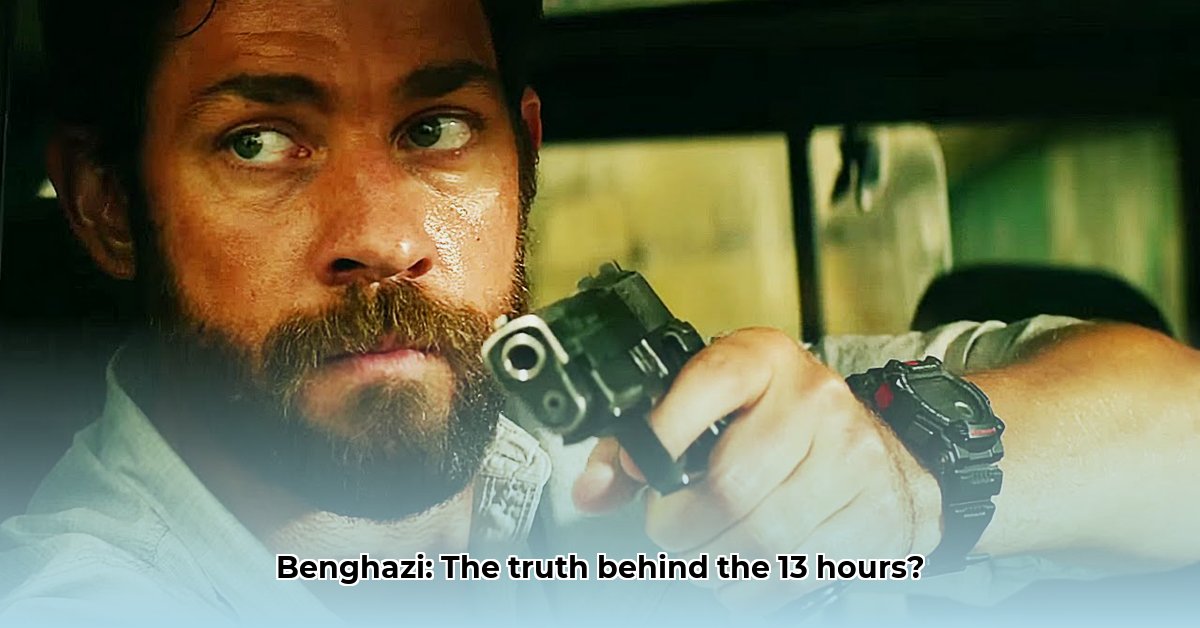
The Film's Narrative: A Gripping Tale, But How True?
The film "13 Hours: The Secret Soldiers of Benghazi" presents a dramatic account of the 2012 attack on the US diplomatic compound in Benghazi, Libya, focusing on the actions of the Global Response Staff (GRS), a team of former military personnel. While undeniably gripping, the film's portrayal of events has sparked significant debate, prompting us to examine its factual accuracy. This article will analyse the film's narrative against documented events and expert opinions, aiming to provide a balanced perspective.
Undisputed Heroism Amidst Chaos
The sheer brutality of the attacks on the US diplomatic compound and the nearby CIA annex is undisputed. The courage and resilience displayed by the GRS team in the face of overwhelming odds, confirmed by multiple firsthand accounts, are undeniable. Their heroic efforts to protect American lives, undertaken at immense personal risk, are testament to their bravery. The tragic loss of American lives remains a stark and universally acknowledged reality.
Points of Contention: The Stand-Down Order and Beyond
One of the most contentious aspects of the film revolves around the alleged "stand-down order" – the claim that orders were given to prevent timely military intervention, thus hindering the GRS's rescue efforts. Official investigations have yielded conflicting conclusions, leaving the precise nature and impact of any such order shrouded in debate. The exact sequence of events leading to Ambassador Stevens' death also remains a subject of ongoing discussion and differing interpretations of the available evidence. Further complicating matters is the film’s portrayal of the CIA station chief, which has drawn criticism.
A Limited Perspective: The GRS Focus and its Implications
The film's narrative prioritizes the experiences and perspectives of the GRS team. While this imbues the film with compelling emotional weight, it also results in a potentially skewed and incomplete narrative. The absence of key political figures and other critical perspectives hampers a comprehensive understanding of the event's complexities, possibly creating a narrative that, while engaging, lacks the balance necessary for a complete picture.
Unpacking the Discrepancies
The film can be viewed as a partial jigsaw puzzle. While the violence and the GRS's bravery are vividly depicted, crucial details remain uncertain and contested. Questions about the existence and impact of any "stand-down order," and the precise sequence of events before Ambassador Stevens' death, remain unanswered. These unanswered questions necessitate continued investigation by historians and researchers.
Moving Forward: Towards a Broader Understanding
The controversy surrounding "13 Hours" underscores the critical importance of approaching films based on real-life events with a healthy dose of skepticism. Understanding such events necessitates considering multiple perspectives and engaging with official reports and investigative journalism. A purely film-based understanding risks a significant distortion of the historical record.
Actionable Steps for a Fuller Understanding
To achieve a more complete understanding of the Benghazi attack, we need a multi-pronged approach:
Filmmakers' Transparency: Filmmakers and studios should acknowledge the areas of contention surrounding their film and consider providing supplementary materials offering alternative viewpoints. Honest engagement with the controversies is essential.
Rigorous Historical Inquiry: Continued impartial analysis using all available evidence by historians and researchers is crucial. This research must be readily accessible to the public.
Government Accountability: Transparent review and eventual public disclosure of all relevant information, accompanied by open discussions of security protocol failures and inter-agency communication breakdowns, are vital.
Public Engagement: The public should embrace critical media literacy, seeking out diverse sources of information, and engaging in open, informed discussion to avoid perpetuating unsubstantiated narratives.
Key Questions and Uncertainties
Did a "stand-down order" impact the response time to the Benghazi attack? What were the exact actions leading to the deaths of Ambassador Stevens and the others? What was the level of coordination between different government agencies and security elements on the ground? These remain key questions and points of continued debate.
Conclusion: Lessons Learned and Future Preparedness
The debate surrounding "13 Hours" underscores the importance of transparency, accountability, and rigorous investigations into complex geopolitical events. The film, while compelling, serves as a reminder of the need for critical media analysis and a commitment to understanding the full, complex picture. The lessons learned from Benghazi should inform future security protocols and inter-agency cooperation to minimize the risk of similar tragedies. While the complete picture may never be fully revealed, continual investigation and open discussion remain essential.